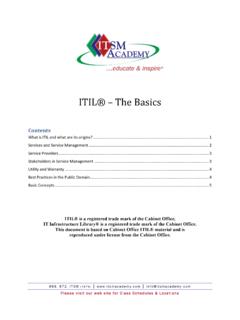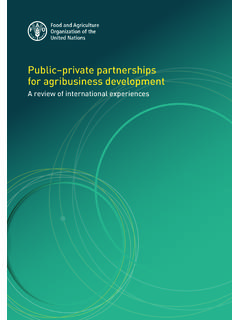Transcription of Agile Service Management Guide V1.0 031615 - …
1 The Agile Service Management Guide By Jayne Gordon Groll Sources and Acknowledgements The Scrum Guide by Ken Schwaber and Jeff Sutherland, July, 2013 The ITSM Process Design Guide by Donna Knapp, ISBN: 978 1 60427 049 5 August 2010 INVEST in Good Stories, and SMART Tasks by Bill Wake, August,2003 ITIL is a registered trade mark of AXELOS Limited. Figures with "Based on AXELOS ITIL material. Reproduced under license from AXELOS." are from ITIL Service Lifecycle Publication Suite Books Crown copyright 2011. Reproduced under license from AXELOS Limited. DevOps Institute About the Author Jayne Groll is an ITIL Expert, Certified ScrumMaster, Certified Agile Service Manager (CASM) and Certified Process Engineer (CPDE). She has over 25 years of IT Management experience that spans multiple industries including legal, telecommunications, retail, non profit, insurance and hospitality. Jayne is co founder of the DevOps Institute whose mission is to bring enterprise level DevOps training and certification to the IT market.
2 Jayne is also President and co founder of ITSM Academy, an ITIL and ITSM training organization. She is active in both the DevOps and ITSM communities and is a frequent webinar and conference speaker. The inspiration for Agile Service Management grew out of Jayne's recognition that end to end IT agility could only be achieved if Agile thinking and practices were exercised by both development and operational teams. Agile Software Development + Agile Service Management = DevOps. DevOps Institute The Agile Service Management Guide Table of Contents introduction .. 5 Being 5 The Agile Manifesto .. 6 What is Agile Service Management ? .. 7 Agile Frameworks and Methods .. 8 Agile Process Design .. 11 Scrum Basics .. 12 Agile Service Management Roles .. 15 Agile Service Management Artifacts .. 18 Agile Service Management Events .. 21 Agile Process Improvement .. 27 Tools for Agile Service Management .. 29 Getting Started .. 30 Glossary of Terms.
3 31 DevOps Institute introduction Demands on IT for innovation and reliability have been steadily increasing since technology became a critical success factor for most businesses. IT has always been asked to do more with less, to improve its integration with business goals and to ensure the ongoing quality of IT services . With the rise of mobile technology, the cloud and an "app" mentality, IT is being asked to do all that and more at breakneck speed. While devices and applications are being introduced faster than ever before, it is the Service behind the technology that is still most important to the customer. As a result, IT will always need to manage its services and IT Service Management (ITSM) practices and processes will always be necessary. The challenge is adapting Service Management practices to changing times so they can enable IT to go faster and deliver more ongoing value to the customer. Rapidly changing IT requirements require rapidly changing IT capabilities.
4 New capabilities require new ways of thinking and performing. IT must learn to be more Agile . Being Agile The MacMillan Dictionary defines Agile as Able to move quickly and easily; able to think quickly, solve problems, and have new ideas. Too often in IT, the concept of being Agile is equated to doing Scrum. While Scrum is an excellent framework for managing complex projects, the application of Scrum practices does not necessarily increase an organization's agility. Software developers recognized this many years ago when they crafted the Agile Manifesto's guiding values and principles. The tenets of agility must first be understood before embarking on Agile practices such as Scrum and other frameworks. Being Agile is a state of mind. It is more perspective than prescription. In order for an organization to be Agile , they must also be Customer centric Lean Collaborative Communicative Adaptive Measurable Consistent Results oriented Reflective DevOps Institute The Agile Manifesto In 2001, a group of seventeen developers met at a ski lodge in Utah to discuss the increasing complexities associated with modern day software development.
5 The developers were frustrated by delays, rework and customer dissatisfaction that were resulting from constraints and were affecting their ability to get projects done on time and on budget. Their goal in crafting the Agile Manifesto was to refocus stakeholders and developers on the aspects of software development that matter most. The Agile Manifesto We value Individuals and interactions Processes and tools Working software over Comprehensive documentation Customer collaboration Contract negotiations Responding to change Following a plan While we value the items on the right, we value the items on the left more. At first glance, the Agile Manifesto may seem to advocate against formal Service Management . Not true. By the authors' own admission, the Agile Manifesto was not meant to be anti methodology but rather an attempt to restore balance. It is a reminder to implement just enough of the items on the right process, tools, documentation, contracts and plans to make the outcome items on the left amazing!
6 The Agile Manifesto is underpinned by twelve principles of Agile software 1. Our highest priority is to satisfy the customer through early and continuous delivery of valuable software. 2. Welcome changing requirements, even late in development. Agile processes harness change for the customer's competitive advantage. 3. Deliver working software frequently, from a couple of weeks to a couple of months, with a preference to the shorter timescale. 4. Business people and developers must work together daily throughout the project. 5. Build projects around motivated individuals. Give them the environment and support they need, and trust them to get the job done. 6. The most efficient and effective method of conveying information to and within a development team is face to face conversation. 7. Working software is the primary measure of progress. 8. Agile processes promote sustainable development. The sponsors, developers, and users should be able to maintain a constant pace indefinitely.
7 9. Continuous attention to technical excellence and good design enhances agility. 10. Simplicity the art of maximizing the amount of work not done is essential. 11. The best architectures, requirements, and designs emerge from self organizing teams. 12. At regular intervals, the team reflects on how to become more effective, then tunes and adjusts its behavior accordingly. DevOps Institute These principles are not significantly different than the principles that underpin Service Management Be aligned with the business Focus on customer outcomes Ensure ongoing customer value Understand and enable business success Deliver quality IT services Restore Service as quickly as possible Adapt to changing requirements Minimize risks Be effective and efficient Make processes sustainable and repeatable Fulfill IT governance requirements There is clearly alignment between the objectives of the Agile Manifesto and the objectives of Service Management . Unfortunately, that alignment does not necessarily translate into end to end agility.
8 IT must now learn to be Agile throughout the entire Service lifecycle from concept to retirement. Agile Software Development + Agile Service Management = Agile IT (DevOps). What is Agile Service Management ? Agile Service Management ( Agile SM) ensures that ITSM processes reflect Agile values and are designed with just enough control and structure in order to effectively and efficiently deliver services that facilitate customer outcomes when and how they are needed. The goals and objectives of Agile Service Management include Ensuring that Agile values and principles are embedded into every Service Management process from design through implementation and continual improvement Improving IT's entire ability to meet customer requirements faster Being effective and efficient (lean) Designing processes with just enough scalable control and structure Provide services that deliver ongoing customer value Agile Service Management encourages a continuous learning environment and promotes better collaboration between development and operational teams by cross pollinating vocabulary and methods.
9 There are two aspects of Agile Service Management : Agile Process Design and Agile Process Improvement. DevOps Institute Agile Process Design Agile Process Design applies the same approach to process design that software developers apply to product development. Each process is built and potentially released in small, frequent increments. New procedures and behaviors are introduced gradually, providing greater opportunity for normalization as well more frequent feedback and input to Guide the future direction of the process. An iterative and incremental approach to process design also allows ITSM processes to mature organically and holistically. Dependent increments can be built simultaneously or in succession. Most importantly, the organization can test the boundaries of just enough process throughout the Service lifecycle. Agile Process Design does not attempt to redefine the underlying principles of process design. There are solid, proven best practice approaches for process design, including those described in The ITSM Process Design Guide by Donna Knapp.
10 Agile Service Management supplements those principles with Agile thinking and practices. Agile Process Improvement Agile Process Improvement seeks to continually align Service Management with Agile values and principles as part of Continual Service Improvement (CSI). Processes are regularly audited and reviewed to ensure that they are at the right level of control and do not drift from just enough to too much or not enough . Most importantly, Agile Process Improvement identifies and eliminates bottlenecks or waste in order to keep ITSM relevant, efficient and effective in the face of changing customer requirements. Agile Service Management is framework agnostic and does not attempt to redefine any of the ITSM processes. ITIL and other Service Management frameworks have done an excellent job of describing best practices for managing IT services , including the processes that are necessary for a complete Service lifecycle. Agile Service Management supplements those frameworks with Agile thinking and practices.








